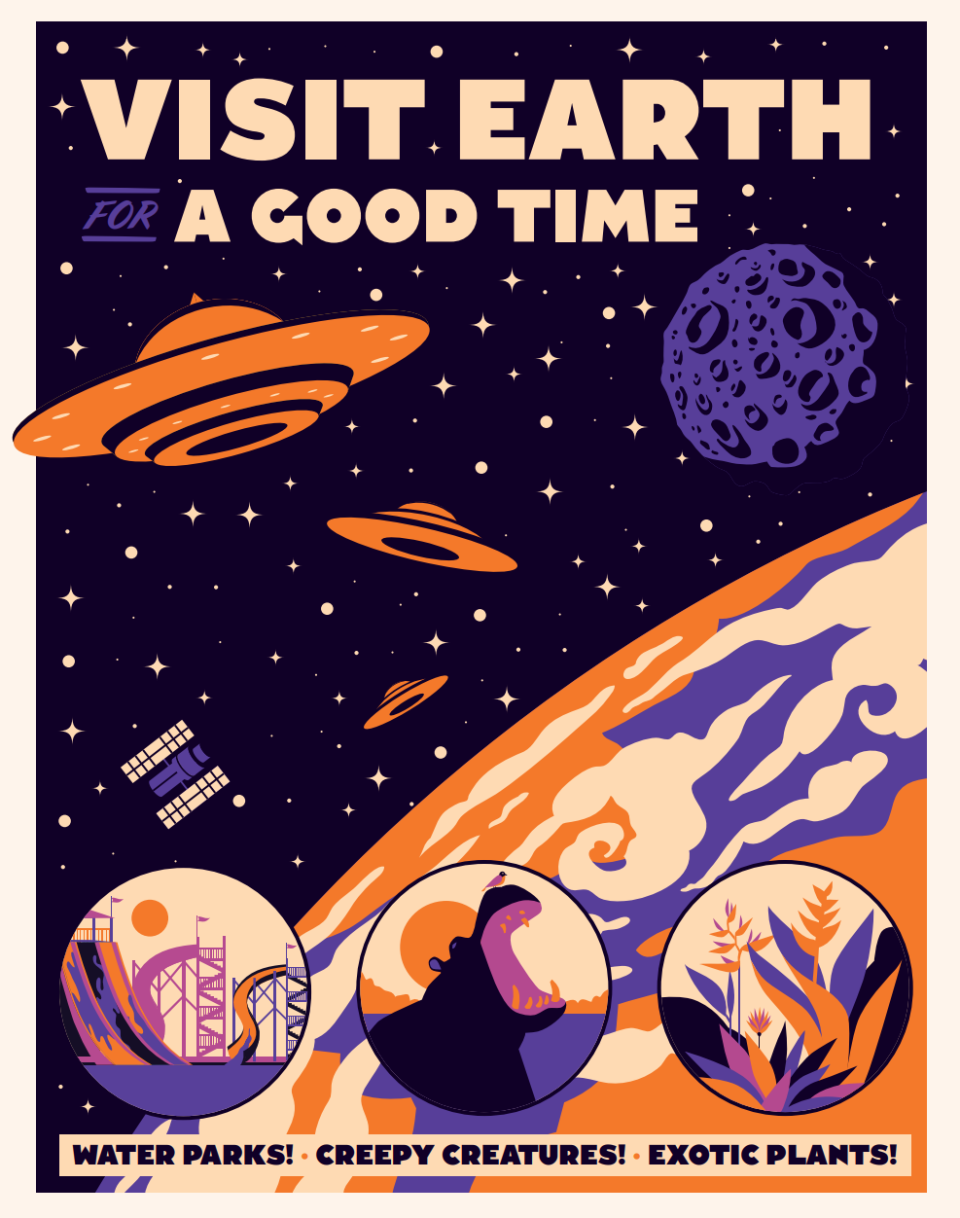How to talk to your kids about aliens: 'Is There Anybody Out There?'

Is there anybody out there in space?
It's a question we've all wondered. Given all of the advances in space telescopes, robotic missions to other planets and even the wild headlines related to UFOs and possible extraterrestrial visitation these days, the question can seem more pressing than ever. And for children, the question can feel frightening, fascinating and everything in between, given some of the sensationalism that surrounds the subject.
To help sort out fact from fiction, author and podcast host Laura Krantz has written "Is There Anybody Out There?: The Search for Extraterrestrial Life, from Amoebas to Aliens," a new book from Abrams Books for Young Readers coming out on Oct. 3, 2023. The book takes a rational look at the search for extraterrestrial intelligence, the flyby of interstellar object 'Oumuamua and even well-known examples of UFO lore like the July 1947 crash of either a flying saucer or a secret U.S. military balloon outside Roswell, New Mexico,
Space.com spoke with Krantz to learn about the book, her take on the UFO buzz these days and even some tips on how to talk to kids about aliens.
Related: The search for alien life

Is There Anybody Out There? (A Wild Thing Book): The Search for Extraterrestrial Life, from Amoebas to Aliens: $19.99 at Amazon
Author Laura Krantz, host of the "Wild Thing" podcast series, takes a deep dive into the search for extraterrestrial life and the UFO phenomenon in this beautifully illustrated and thoroughly researched book for young readers.View Deal
Space.com: First off, I have to say that this is a beautifully illustrated book.
Laura Krantz: I just love it. I love the colors. I love this sort of like blocky illustration style. I just I think it turned out really, really well. [Illustrator Rafael Nobre] has a good sense of humor, too. Like he's able to incorporate some of the funnier stuff into like, great photos. Like there's the scene of an alien trying to cook life, I just I love that one.

Space.com: What was the inspiration for the book?
Krantz: The book is really a spin-off of the Wild Thing podcast. When I started doing the podcast, I wasn't really thinking about kids at all, I was thinking about adults. And I started getting letters from parents who were listening with their kids, teachers who were using elements of the podcast in their classroom to talk about like, evolution, DNA evidence and the scientific method. And I started talking to my agent, and she suggested doing a middle-grade nonfiction book, because that is really an area where teachers love this kind of information and resources for kids.
But it's interesting to write this kind of stuff. Because when you're doing it for an adult audience, you assume they know what DNA is, they know what evolution is. They know what all these sort of terms mean, at least sort of obliquely. But when you're writing for kids, you're like 'Crap, I have to understand what this actually is, and be able to explain it in plain language!' So it was like getting a crash course in science education.

Space.com: Why do you think it's important for young people to read this book?
Krantz: I think one of the most important things about it is that [the question of alien life] kind of sits firmly in the gray area. There's no answer to the question "Is there anybody out there?" Just like there's no answer to the Bigfoot question. It's like, this is an area to explore. This is an area to think about things scientifically and wonder and hypothesize. And guess what? We don't have a solid answer.
And in some ways, it's like teaching kids to be comfortable with the idea that there's no answer, because I think we are in a society now where things tend to be pretty black and white, good or bad, right or wrong, one side or the other side. And with this, you just kind of have to be like, 'There might be aliens out there; I can see both sides of this argument.' I can see all different ways this might go. And I still don't know for sure. And I think that that's valuable.
And then I think the other thing, too, is it's helpful to help. It's helpful for kids to see how science works, that science has such a long timeline, that the work that was done in the '50s and '60s and '70s on space science, many of those scientists aren't around or won't be around to see where the sort of seeds that they planted end up. And I think that that's sort of important for kids to understand — that science is constantly building on itself and revising and resubmitting, and trying to figure it out as best as it can using the evidence at the time. I think those are two really valuable things.
And then, also, space is cool.

Space.com: I read in your introduction like you were not familiar with the UFO topic before getting into this, right?
Krantz: What really caught my attention was, firstly, the 'Oumuamua story, which I just thought was fascinating. I mean, we guessed that there were things coming in from outside our solar system. But we hadn't really been able to say that for sure. And this is the first moment we were like, 'This thing is from very far away.' And I think that that's just kind of a cool thing to think about — like, this moment in time, we have this realization of just how big the universe is, and what kinds of things are traveling through it.
And also seeing photos coming out of the James Webb Space Telescope. And granted this that was after this project was mostly finished. But it's hard not to look at those photos and just have your jaw drop with, you know, how amazingly beautiful and yet, kind of terrifyingly awesome they are. A lot of those photos make you feel very small and insignificant, which is, I guess, kind of a good reminder of our place. And in the grand scheme of things.
Space.com: What do you make of the current UFO buzz in the U.S. government?
Krantz: I saw how, like, crazy, everybody went over the AATIP program [an alleged U.S. Department of Defense UFO study program]. And when the announcement came out about that, like, people lost their marbles; the headlines on that were just constant. And so that was the moment where I was like, 'There's something to be done here on this' and sort of take my glancing interest in it and pull in these threads where it's obvious that this is a question that people think about a lot, even if it's not something we're talking about day to day.
I think that it's a perfect opportunity to apply some rational thought. So, for instance, the whistleblower who testified in front of Congress, he said that people told him that they had recovered bodies, but he hadn't seen them for himself. So that to me is the first red flag. It's like, if you're the whistleblower, you need to have been seeing some of the stuff, you can't just use hearsay. Generally, that's not admissible in court, from what I understand about legal proceedings. So I think that should be a rational thing. And in science, too, and in scientific inquiry.
I don't doubt that there's some weird stuff up in the sky, and that pilots are seeing things. I do think there needs to be a recording process for that, that does not have a stigma attached to it.
Related: UFOs and UAP: History, sightings and mysteries

Space.com: What do you hope kids take away from the book?
Krantz: That wonder is a huge asset. I think it's so valuable. And I think we kind of beat the wonder out of people as they become grownups. It's like, there's these boxes, you have to check in these things you have to do and the wonder kind of slips by the wayside. But wonder is so important, because it gets you figuring out how your world works. And it gets you thinking about things from different perspectives. And scientifically, like the first step of the scientific method is, it's about wonder. Ask a question; what are you wondering? And I think that that is a really valuable thing for kids.
RELATED STORIES:
— Alien life may not be carbon-based, new study suggests
— NASA appoints new head of UFO research
— Alien mummies in Mexico? NASA's UFO study team says don't bet on it
And I also think it's a valuable thing for adults to wonder about the world around you, to wonder about what life is like for other people to just sort of have this curiosity and questions and continuing to maybe question your own thoughts on things and beliefs. And, you know, it extends beyond science. I think wonder is a skill that we sometimes lose as we get older.
"Is There Anybody Out There?: The Search for Extraterrestrial Life, from Amoebas to Aliens," is currently available for pre-order and will be released on Oct. 3, 2023.

